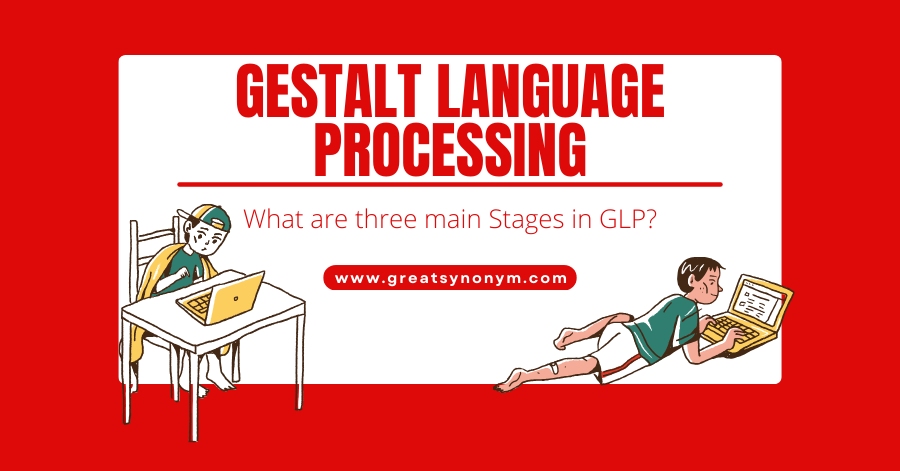Hello viewers! Great Synonym welcomes you back to another amazing blog post on the topic of Gestalt Language Processing (GLP) in speech-language. Nowadays, this topic is trending. Keep reading the blog till the end to get a better understanding of the topic.
What is Gestalt Language Processing?
Gestalt Language processing(GLP) is the process of learning a language with the help of complete phrases or gestalt. Unlike the Analytical language learning procedure, GLP focuses on the whole gestalt instead of single or multiple words. In English language, the word “gestalt” means the sum of parts. Which means it is a combination of two or more words. Mostly we prefer to begin the learning of a kid by teaching him single words. After that, we told them to use these words to make a sentence. Contrarily, in GLP, we teach our kid a complete sentence first. Then, break the phrase into words. So, we can say that Gestalt Language Processing is the reverse method of normal language processing.
Difference between ALD and GLP:
Now, we will separately see the difference between both ALD and GLP methods of learning language.
Analytical Language Development (ALD):
Analytical language development (ALD) is a conventional method of teaching a language to newbies. First, we are taught some words and after that, we are taught how you make a sentence or phrase using these words. Example: I, we, me, you, boy, girl, is, are, am, who, when, why, a, an, go, goes, gone, to, for, in, today, every, each, day, night, school, house, yesterday. Using these words, we can easily make a sentence. Like, “I am a boy who goes to school every day.” This is how we can teach the newbies using the ALD method.
Gestalt Language Processing (GLP):
Gestalt Language Processing (GLP) is completely the opposite method of learning language from the previous one. In this method, we learn to speak or write a gestalt, first. Then, we break the sentence into the words to get the further insights on words. This process is less time-consuming and has more accuracy than ALD. Example: “I am a girl who goes to school every day.” Then, we break the phrase into the following words: day, every, school, to, goes, who, girl, a, am, I. Then, we will teach the kid about the meaning and the purpose of using these words in a sentence. This method can prove helpful in learning a language.
Gestalt Language Processing Stages:
Definitely, as a language processing unit. Gestalt language processing involves three main stages to gain mastery of language. The following are the three main stages:
1-Learn and Repeat:
The first stage of learning GLP is to learn some phrases or groups of words and then try to use this phrase over and over again after some time delay. Definitely, You must know the purpose and the usage of the phrase. Like, if you have learned the phrase “How are you doing?” Certainly! You can use the phrase “How are you doing?” to inquire about someone’s well-being or current state. It’s a common and informal way to ask about someone’s health or general situation.
2-Breaking into Words:
The next stage is to break the phrase into words. And then find other related words. We can break the previous phrase into these words “doing”, “you”, “are”, and “how”. Now, you can get help from a dictionary or the internet to find all the relevant words. For “you”, he, she, they, their, I, we, us, them, our, his, her, etc. are relevant words. For “doing”, do, does, done, etc. are the most relevant words. This is how you do your research and find the best relevant words.
3-Formation of a New Phrase:
The last and final stage is to form a new phrase by using the relevant words you have extracted earlier. This will help you get a better understanding of the words used in the phrase.
Gestalt Language Processing Goals
Gestalt Language Processing (GLP) goals aim to support individuals to acquire proficient language skills. These goals typically focus on:
1-Enhancing Memory Consolidation:
The goal of Gestalt language processing is to enhance the ability to remember a phrase as a single unit rather than as individual words. This helps improve the capacity to retain things in the long term. Additionally, this approach teaches individuals to deal with challenges more effectively.
2-Vocabulary Expansion:
Another goal is to expand the vocabulary of a kid. I think Gestalt Language Processing can prove to be a healthy exercise for kids. It helps them to engage with the new words which can lead to vocabulary expansion.
3-Promotes Creativeness:
Gestalt Language Processing can promote creativity among kids by encouraging flexible language use and fostering a supportive environment for creative expression. This approach helps children perceive connections and patterns in language.
Conclusion:
In conclusion, Gestalt Language Processing is an innovative method of language learning that emphasizes a primary focus on creative thinking and overall awareness. GLP, on the other hand, puts the whole picture first, which makes learning and remembering more effective.
The goal of the GLP is to give people, especially children, advanced language skills that go beyond basic language skills by focusing on memory improvement, vocabulary growth, and encouraging imagination. Accepting GLP opens up a world of language study and creative expression, which leads to better communication and brain growth. Dive into the world of GLP to get the most out of learning a language! I hope all of you have enjoyed reading the blog post.


